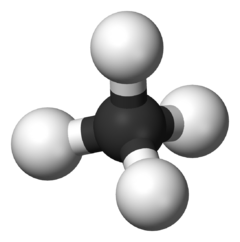Hydrocarbon
Giao diện

Hydrocarbon là các hợp chất hữu cơ mà phân tử chỉ gồm carbon và hydro. Chúng lại được chia thành hydrocarbon no, hydrocarbon không no, cycloalkan và hydrocarbon thơm.
Các văn bản liên quan đến hydrocarbon
[sửa]- Even though alkanes are relatively unreactive and rarely involved in chemical reactions, they nevertheless provide a useful vehicle for introducing some important general ideas. Mặc dù alkan tương đối kém phản ứng và hiếm khi tham gia vào các phản ứng hóa học, tuy nhiên alkan vẫn hữu ích để giới thiệu tổng quát các tính chất quan trọng.
- John McMurry, Organic Chemistry 8th ed. (2012), Ch. 3 : Organic Compounds: Alkanes and Their Stereochemistry
- Cyclic molecules are so commonly encountered throughout organic and biological chemistry that it’s important to understand the consequences of their cyclic structures. ... A cycloalkane is a saturated cyclic hydrocarbon with the general formula CnH2n. In contrast to open-chain alkanes, where nearly free rotation occurs around C-C bonds, rotation is greatly reduced in cycloalkanes. Các phân tử dạng vòng thường gặp trong hóa học hữu cơ và sinh học.[...] Cycloalkan là một hydrocarbon vòng, no có công thức chung CnH2n. Ngược lại với các alkan mạch hở, liên kết C-C gần như tự do quanh trục liên kết, thì sự quay quanh trục liên kết giữa các nguyên tử carbon ở cycloalkan giảm đi rất nhiều.
- John McMurry, Organic Chemistry 8th ed. (2012), Ch. 4 : Organic Compounds: Cycloalkanes and Their Stereochemistry
- When alkanes are heated to a high temperature, both C–H bonds and C–C bonds rupture, a process called pyrolysis. In the absence of oxygen, the resulting radicals can combine to form new higher- or lower-molecular-weight alkanes. Radicals can also remove hydrogen atoms from the carbon atom adjacent to another radical center to give alkenes, a process called hydrogen abstraction. Nhiệt độ cao, cả liên kết C–H và liên kết C–C trong alkan đều bị nhiệt phân. Trong trường hợp không có oxy, các gốc tự do tạo thành có thể kết hợp với nhau để tạo thành các alkan mới có trọng lượng phân tử cao hơn hoặc thấp hơn. Các gốc tự do cũng có thể loại bỏ các nguyên tử hydro khỏi nguyên tử carbon nằm cạnh một trung tâm gốc khác để tạo ra alken, một quá trình gọi là phản ứng tách hydro.
- K. Peter C. Vollhardt, Neil E. Schore (2011) Organic chemistry : structure and function 6th ed. Chapter 3. Reactions of Alkanes
- Breaking an alkane down into smaller fragments is also known as cracking. Such processes are important in the oil-refining industry for the production of gasoline and other liquid fuels from petroleum. Cracking là quá trình phân hủy một alkan thành các mảnh nhỏ. Quá trình cracking rất quan trọng trong ngành lọc dầu để sản xuất xăng và các nhiên liệu lỏng khác từ dầu mỏ.
- K. Peter C. Vollhardt, Neil E. Schore (2011) Organic chemistry : structure and function 6th ed. Chapter 3. Reactions of Alkanes
- Alkanes lack functional groups, so they do not undergo the kinds of electrophile – nucleophile reactions typical of functionalized molecules. In fact, alkanes are pretty unreactive. However, under appropriate conditions, they undergo homolytic bond cleavage to form radicals, which are reactive species containing odd numbers of electrons. This is another situation in which the structure of a class of compounds determines their function. Các alkan thiếu các nhóm chứcnên chúng không tham gia phản ứng electrophile - nucleophile điển hình của các phân tử chứa nhóm chức khác. Trên thực tế, alkan khá kém tham gia phản ứng. Tuy nhiên, trong những điều kiện thích hợp, liên kết giữa các nguyên tử trong alkan được phân cắt đồng ly để tạo thành các gốc tự do, là những gốc chứa số electron lẻ. Đây là một ví dụ trong đó cấu trúc của một loại hợp chất quyết định chức năng của chúng trong phản ứng hoa học.
- K. Peter C. Vollhardt, Neil E. Schore (2011) Organic chemistry : structure and function 6th ed. Chapter 3. Reactions of Alkanes
- The relative reactivities of the various types of alkane C–H bonds in halogenations can be estimated by factoring out statistical contributions. They are roughly constant under identical conditions and follow the order CH4 < Primary CH < Secondary CH < Tertiary CH ... The reactivity differences between these types of CH bonds are greatest for bromination, making it the most selective radical halogenation process. Chlorination is much less selective, and fluorination shows very little selectivity. Khả năng phản ứng tương đối của các loại liên kết C–H trong alkan khác nhau trong quá trình halogen hóa có thể được ước tính bằng cách phân tích phân bố thống kê. Chúng gần như không đổi trong các điều kiện giống hệt nhau và tuân theo thứ tự CH4 < CH bậc một < CH bậc hai < CH bậc ba ... Sự khác biệt về khả năng phản ứng giữa các loại liên kết CH này là lớn nhất đối với phản ứng brom hóa, khiến phản ứng brom hóa là phản ứng halogen hóa gốc chọn lọc nhất. Quá trình chlor hóa ít chọn lọc hơn nhiều và quá trình fluor hóa rất ít tính chọn lọc.
- K. Peter C. Vollhardt, Neil E. Schore (2011) Organic chemistry : structure and function 6th ed. Chapter 3. Reactions of Alkanes
- The conformational analysis of cyclohexane enables us to predict the relative stability of its various conformers and even to approximate the energy differences between two chair conformations. Phân tích cấu dạng của cyclohexan cho phép dự đoán độ ổn định tương đối của các các cấu dạng, thậm chí ước lượng được sự khác biệt về năng lượng giữa hai cấu dạng ghế.
- K. Peter C. Vollhardt, Neil E. Schore (2011) Organic chemistry : structure and function 6th ed. Chapter 4. Cycloalkanes

